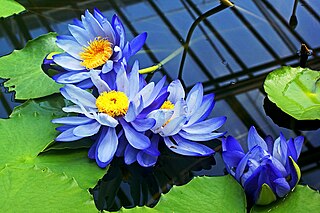Dong or DONG may refer to:

Viburnum is a genus of about 150–175 species of flowering plants in the moschatel family Adoxaceae. Its current classification is based on molecular phylogeny. It was previously included in the honeysuckle family Caprifoliaceae.

Argyroxiphium is a small genus of plants in the family Asteraceae. Its members are known by the common names silversword or greensword due to their long, narrow leaves and the silvery hairs on some species. The silverswords belong to a larger radiation of over 50 species, including the physically different genera Dubautia and Wilkesia. This grouping is often referred to as the silversword alliance. Botanist P. H. Raven referred to this radiation as "the best example of adaptive radiation in plants".

Argyroxiphium sandwicense subsp. macrocephalum, the east Maui silversword or Haleakala silversword, is a rare plant, part of the family Asteraceae. The silversword in general is referred to as ʻāhinahina in Hawaiian.
Snowball bush is a common name for several ornamental plants which produce large clusters of white flowers and may refer to:
Hnahthial is the headquarters of Hnahthial district in the Indian state of Mizoram. The term Hnahthial is a Mizo term which means Phrynium capitatum, a plant which grows in plenty in Hnahthial.
Diplostephium macrocephalum is a species of flowering plant in the family Asteraceae. It is found only in Ecuador. Its natural habitats are subtropical or tropical moist montane forests, subtropical or tropical dry shrubland, subtropical or tropical high-altitude shrubland, and subtropical or tropical high-altitude grassland. It is threatened by habitat loss.

Noticastrum is a genus of South American flowering plants in the daisy family.

Carpesium is a genus of flowering plants in the aster family, Asteraceae. They are distributed in Europe and Asia; most occur in China and several are endemic to the country.

Trifolium macrocephalum is a species of clover known by the common name largehead clover.

Viburnum × carlcephalum, common name fragrant snowball, is a hybrid flowering plant in the family Adoxaceae, of garden origin. It is a cross between V. carlesii and V. macrocephalum.

Nymphaea gigantea is a species of aquatic perennial herbaceous plant native to Australia and New Guinea. N. gigantea is a tropical and sub-tropical species that establishes tubers in the muddy bottoms of still waters.

Eupatorium macrocephalum Less. aka pompom weed, is a cosmopolitan perennial plant belonging to the family of Asteraceae and regarded as an invasive weed in some countries. It is native to the southern United States, Central America, South America and was introduced to South Africa. It is classed as a principal weed in Brazil. In South Africa it has been cultivated as an ornamental, is often found on roadsides, and has become of concern for its invading of undisturbed climax grassland and wetlands since the 1960s. It is closely related to Siam weed, and is one of some 268 species in the genus.

Phrynium is a plant genus native to China, India, Southeast Asia, New Guinea and Melanesia. It was described as a genus in 1797.

Stachyphrynium is a genus of plants native to China, the Indian Subcontinent, and Southeast Asia. It was first described as a genus with this name in 1902.

Ptilotus manglesii, commonly known as pom poms is a herb native to Western Australia. The Noongar name for the plant is mulla mulla.

Viburnum macrocephalum, common name Chinese snowball, is a species of flowering plant in the family Adoxaceae, native to mainland China. Its fertile form, Viburnum macrocephalum f. keteleeri, is of great cultural significance in China.
Copestylum macrocephalum is a species of syrphid fly in the family Syrphidae.

Stachyphrynium placentarium is a species of plant in the family Marantaceae. Its basionym was Phyllodes placentaria Lour. and was subsequently long placed as various species in the genus Phrynium. The species is widespread throughout Asia, with records from Bhutan, southern China, India, Indo-China and Indonesia; no subspecies are listed in the Catalogue of Life.

Phrynium pubinerve is the type species of the plant genus Phrynium, in the family Marantaceae. It is widespread throughout Asia, with records from India, China, and Indo-China through to New Guinea; no subspecies are listed in the Catalogue of Life.












